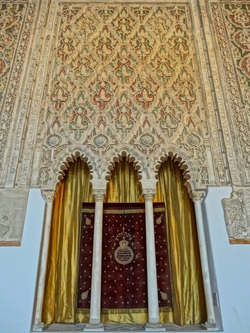
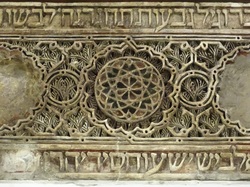
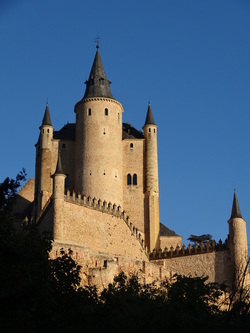
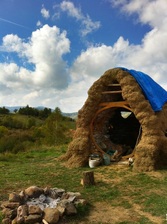
In our post on Andalusia, we started the story of the Jews in Spain during the rule of the Moorish Kingdoms. As we traveled to the central region of Spain to visit the capital of Madrid, we will end that story. Previously we learned that the Moorish Kingdoms were tolerant of the Jews, creating a golden age where Jewish culture and art thrived. But as more conservative factions came to rule in Moorish Spain, Jews fled to the territory of the Christian Kingdoms, where they were not killed largely because those kingdoms needed them in the fight against the Moors.  The Ark in El Transito Synagogue Much of the history comes to a head in Toledo. In 1085, Alfonso VI welcomed the fleeing Jews to Toledo by granting Jews equality with Christians and even some rights of the nobility. 40,000 Jews served in Alfonso VI’s army against the Moors, until a key battle was lost in 1108. The Jews were blamed and a riot broke out that killed many Jews and saw their homes and synagogues burned down while Alfonso lay on his deathbed, helpless to stop the madness. For the next 300 years patterns like this would continue where Jews were given a modicum of power by one ruler, only to be massacred and exiled by the next. By 1391, anti-Semitism reached a fever pitch and Jews were butchered in Seville, Cordoba, and Toledo. Corpses of women and children lay heaped in the streets and in destroyed synagogues.  Stucco work - El Transito From the massacres rose to popularity the Dominican Vincent Ferrer, who forced Jews to either convert or be forced to live in ghettos where nearly any livelihood was illegal as was flight from the country. But as Jews did convert, no one believed their faith and hatred of these “New Christians” was the dominant attitude. Thus were sown the seeds of the Spanish Inquisition, aimed at finding out if converted Jews (conversos) were authentic in their faith. By 1492, hatred of Jews was so strong that Isabelle and Ferdinand signed the edict of expulsion, which forced all unconverted Jews to leave the country forever, with all of their property and wealth confiscated by the state. The majority (90,000) fled to Turkey and the Ottoman Empire while 20,000 others died in the process of fleeing. Those converses who stayed were subjected to the torture and persecution of the Spanish Inquisition, which didn’t fully end until 1834. But despite the sadness about the oppression of minorities in medieval Spain, there were many beautiful sites to be seen. In Madrid the Palacio Real (Royal Palace), the Botanical Gardens, and the numerous beautiful piazzas were all impressive. In Toledo, the mudejar style of the surviving synagogues was beautiful and the huge cathedral there is impressive.  Alcazar in Segovia But perhaps most memorable for us was the picturesque town of Segovia, whose old city was fed by an aqueduct that reaches 28 meters at its tallest point. Built during Roman times to supply a fort on the hilltop that would become the city, the aqueduct uses no mortar (it is only stacked stones) and is truly an act of engineering genius, testified to by the fact that it still stands 2,000 years after its construction. It is amazing! The Alcazar (palace) in Segovia is equally beautifully – its Romantic style towers climbing into the sky on the site of the old Roman fort. Plopped down in the middle of the town between the Alcazar and Aqueduct is the last great Gothic Cathedral in Spain, also stunning. Walking down into the countryside in order to get views of the Alcazar and Cathedral as the sun set on the city was one of our favorite times in Spain. After the sun went down we sped home on our first trip ever on a high speed train – a mere 30 minute journey. After our day trips to Toledo and Segovia, we spent the day in the botanical gardens of Madrid, enjoying the landscaping and the beauty of the crystal palace there. Then it was off on a night bus to Barcelona, where we would have one of our most dangerous adventure yet! See all the pics of Madrid, Toledo and Segovia by clicking here.  Mudhouse Postscript: We are back in Bulgaria now and getting ready for our trip to India. But if you want to see some pics of our mountain adventure in Bulgaria with our friends Kaloyan and Rumiana, click here. We had great times visiting a Bulgarian masterpiece of a house (from the days of Turkish occupation) and helping to build a hobbit-like mudhouse at the Future Now volunteer project high up in the hills. After getting back from our trip, we spent a 13 hour day making homemade lutenitza, inspired by our Barcelona friends Simona and Walter! If you are friends or family on Flickr you can click on the link to see the pics!
0 Comments
How is it that one tiny area of land can embody man’s greatest achievements and his most despicable depravity? The most Southwesterly part of Europe manages to do just this. We arrived in Lagos, Portugal and were dazzled by its gorgeous coastline replete with fresh seafood restaurants servings up the famous sardines native to the area. It is from Sagres, just a few kilometers away, that Prince Henry the Navigator set up his famous school that would usher in the age of Discovery. Sagres sits on the cliffs overlooking the Atlantic and was long considered the edge of the world by sailors. It was thought that to sail far beyond its shores would lead only to monsters, darkness, and to boats falling off the very face of the earth. Henry’s school accumulated the knowledge that would allow for this “edge” to be challenged. Through the development of an improved astrolabe, improved maps, and the new ship design of the caravel, he was able to send its students to places hitherto uknown in the world. Columbus studied there before getting sponsorship by Spain for his voyage to the New World. In 1488 Bartolmeu Dias was the first man to round the Cape of Good Hope and in 1498, Vasco Da Gama opened up the sea route to India, both after studying at Henry’s school. 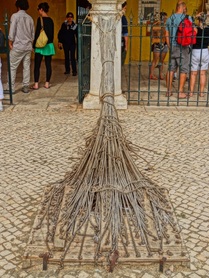 And yet the area has a nefarious past as well. For it was here in 1444, that Europe’s first Slave market (the Mercado de Escravos) was opened. From Lagos, thousands of Africans were dispersed through Europe, unjustly forced to perform labor after being snatched from their homes. The famously religious Prince Henry (who was part of the Order of Christ, deriving from the Knights Templar) received one-fifth of the selling price for each slave as he was the major sponsor of the expeditions to Africa. The image to the left depicts the front of the slave market, where ropes have been strung together to represent that first shipment of 275 slaves brought into Europe in 1443. 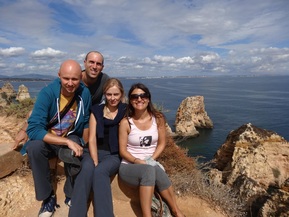 With these themes juxtaposed in our minds, we met up with some wonderful couchsurfers in Lagos who made our stay there truly memorable. Lijana and Andrius are Lithuanians who are traveling the world, living in different locations, and supporting themselves remotely with their website that sells Halloween Costumes (check out their site if you need a costume!). They were an inspiring couple to meet with as they took their wanderlust and made it into a viable profession while also generously sharing their home with surfers like us. But beyond serving us delicious vegetarian meals, they also picked us up from our hike along to the coast to the gorgeous Ponta da Piedade (the Point of Piety) and drove us up to Sagres, where we saw the cliffs that seaman for years considered the edge of the world. But after a quick photo where all the tourists were, we got to go a lot deeper. Adrius & Lijana are avid rock climbers and discovered some great routes just down on the famous cliffs. They took us to their favorite spot, an isolated cove where you can climb the sheer rock walls while the crashing waves and setting sun provides an utterly picturesque background (as you can see from our numerous photos and videos on our Flickr page). As we climbed at the edge of the world with our new friends, we felt a tinge of inspiration and trepidation that those long-gone sailors must have felt looking out into the unknown before setting off on their journeys. 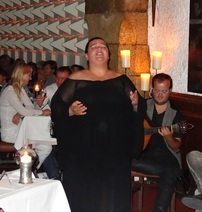 Fado Singer With so many sailors never returning from their journeys to the unknown, a musical art form known as Fado would eventually develop. Translated as “fate” Fado is a mournful, soulful style of singing where the singer bemoans the tragedies of the sea, unrequited love, and our inability shake loose from what fate offers us. Upon arriving in Lisbon, the capital of Portugal, we attended a Fado concert our first night to see what is all about. We enjoyed the music and the singers’ voices, though the current tradition of Fado is far from the spontaneous plebian singing that dominated the docks and taverns of old Lisbon. Rather, Fado is now sung in classy restaurants where a minimum amount of money must be spent to even sit down. The rest of our time in Lisbon was spent exploring the old neighborhood of Alfama, the gorgeous Manueline sea-inspired architecture of Jerónimos Monastery, Belem Tower, and the Monument to the Discoveries. The intricate detail work in the carvings of the cloister at Jerónimos Monastery were particularly impressive. We also filled ourselves up with fried cod-balls and sandwiches in the local food bars, an interesting cultural experience in which locals will eat a bite and a beer quickly at the bar rather than pay more to sit down at the tables outside. But in the end we grew tired of Portuguese food and were delighted to partake in some excellent all-you-can sushi restaurants that parlayed Lisbon’s wonderful seafood into delicious Japanese morsels at a fraction of the price of other areas we have traveled! On a daytrip from Lisbon we went out to the fairytale land of Sintra, which is overlooked by the remains of an ancient Moorish Castle dating from the 8th Century. But it is most famous for its two palaces: the Sintra National Palace and the Pena Palace. The Sintra National Palace was built on the site of another Moorish Castle, which was repurposed for the crown when King Afonso Henriques conquered Portugal from the Moors. It contains a mixture of Gothic, Manueline, and Moorish styles that makes for an interesting visit. Afterwards, you trek up the hill (or take the tourist bus!) to the high walls of the Moorish Castle, overlooking the fairytale-like Pena Palace. Built between 1842-1854 by a German architect, the Palace resembles the castles sitting along the Rhine River, but with a Portuguese twist. It’s frankly garish color scheme wasn’t as beautiful as it was amusing for Neda and me to explore though one can’t help but be won over by the effusive charm of the place. See all of our pics from Lisbon and Sintar here. Our time in Portugal was packed full of sights, history, and new friends. We felt both inspired and saddened by the history of the place, and would soon feel tired as we hopped on the nightbus to Madrid to begin the last leg of our trip through Spain! Postscript: Those hardcore fans of our blog may have noticed that some of our flickr pages from previous posts on Italy didn’t have any pictures in them. Jeff has spent the last few days finally sorting and cleaning up those albums from Italy, so if you’d like to take a look at the pics here is each post, with its corresponding picture page: Naples & Amalfi Coast Post & the Naples & Pompeii Pics & the Amalfi Coast Pics Sicily Post & Catania and Siracusa Pics & Agrigento, Valley of the Temples, and Palermo Pics 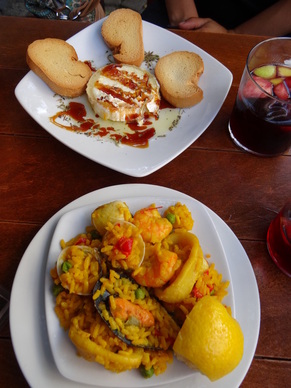 Paella, Baked Goat Cheese, and Sangria Our arrival in Seville (and into Spain) was immediately greeted by some of the best offerings of Spanish culture. As it was late at night, we found a cervezeria right outside of our pension that was serving ice cold “tinto di verano” (wine of the summer) and delicious tapas. We stumbled through the language barrier to get a plate of delicious Iberian ham (similar to prosciutto in texture and taste) topped with aged cheese and some delicious albondigas (meatballs in a savory sauce). The next day we continued this onslaught of delicious bites with little plates of saffron speckled paella, baked goat cheese covered in fresh marmalade, and salmorejo, a chilled tomato and bread soup topped with boiled egg and the aforementioned Iberian ham. What a welcome to Spain! As we started to explore the city of Seville and learn about the region of Andalusia, we found that it wasn’t only our taste buds that would be excited. The rich history of the region leaves plenty of eye candy for even the casual observer. It all starts with Southern Spain’s rich Islamic history. 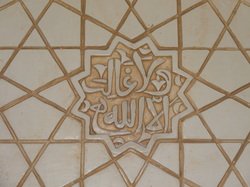 Arabesque Plasterwork In 711 A.D., Islamic leaders invaded the South of Spain (toppling the Visigoth empire that had temporarily ruled following the fall of Rome) and established the Kingdom of Al-Andalus, the root for the modern day territory of Andalusia. During their rule in Spain, the Islamic territories were a model of scientific research, artistic development, and religious tolerance (at least until 1100 or so). From the capital of Cordoba, the largest library in the world (at that time) was collected and massive investment went into the development of palaces and mosques, some of which still remain today. Islamic rule would continue strongly in the region until 1212, when North Catholic Kingdoms defeated most of the Muslim States established in Adalusia. The exception was the Nasrid Kingdom in Granada, which managed to last until 1492. 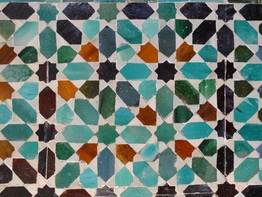 Azulejos - San Bartolome in Cordoba As we toured the palaces and mosques of Islamic Spain, we were awestruck by their use of simple substances like timber and plaster to create amazing décor in a style called arabesque. Imagine delicately carved plaster and carefully painted tiles (called azulejos) all coming together to form an endless interlacing of geometric forms. The Muslims believed that this stream of scrolling geometric patterns was an apt representation for eternity. Each piece is simple and beautiful in its own right, but when put into the context of hundreds of other pieces, the whole attains a beauty that the mind can barely begin to grasp. It’s a form of art that attempts to replicate how difficult it is for our finite minds to perceive something as vast and infinite as God. We started our tour of Moorish Spain with the Alcázar of Seville, a fortress turned palace largely built in 1364, after the fall of the region to the Catholic armies. However, it was largely crafted by Muslim craftsmen from Granada and retains a strong Islamic flair. Perhaps most memorable for us was the domed ceiling in the Ambassadors Hall consisting of carved and gilded interlaced wood (see picture above). From Seville we traveled to Granada, home of the most fascinating of the Islamic relics – the Alhambra. Consisting of an old fort, a palace, and some of the most stunning palatial gardens we have ever seen, the Alhambra is truly a sight to behold. It sits perched atop a hill overlooking Seville and our morning climb to get into the Nasraid Palace at the appointed time already had our hearts beating in anticipation (and exhaustion ;)). The Nasraid Palace is a wonderfully preserved example of the arabesque style and we had to hold our jaws in our hands as we gazed upon its beautiful courtyards, throne rooms, and the geometrically inspired ceilings. An early morning bus ride took us from Granada to the former Moorish capital of Cordoba where explored the Mezquita, a mosque originally built in 786 to establish Cordoba as the heart of Al-Andalusa. The Moors used bits and pieces of the Roman ruins around the city to create a “forest of arches” that creates much the same effect as the geometric patterns discussed above. It is like walking through eternity – at once both humbling but also inspiring. Unlike the impersonal experiences we often feel in cavernous and cold Christian cathedrals, the Moorish architecture brought an intimacy and aesthetic focus on the abstract that was very appealing for us. Perhaps by avoiding direct representation of the infinite (like a person or thing), it allows the mind to stay soft and open for whatever experience it may have of something so beyond comprehension. Unfortunately, the conquering Catholic royalty of northern Spain thought that it was necessary to tear down many of these mosques and build churches directly on top of them to express the domination of Christianity over Islam. In the case of the Mezquita, it was so large that the new rulers settled for putting an entire Cathedral in the middle of the Mosque. It is a very strange thing to see the Cathedral sitting there in the middle of the vast building. For the best illustration of it, see this video. 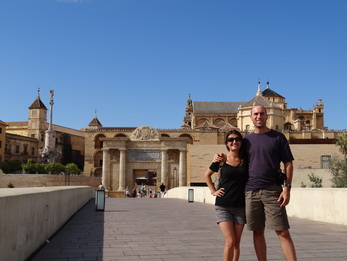 On the Roman Bridge leading to Cordoba For the Jews in Spain (known as Sephardic Jews), their fortunes changed with each conqueror. Jews were treated very poorly by the Visigoth’s who took over from the Romans, being forced to convert or leave the continent under their rule. When the first conquerors of Al-Andalus arrived, many Jews sided with them to get relief from the oppression. They were welcomed into Muslim society as dhimmis (non-Muslim members of monotheistic faiths). Their mastery of Arabic allowed for a golden age in which Jews held high positions in diplomacy, medicine, commerce, and agriculture. But as time went on, more conservative Muslim factions such as the Almohads took over Muslim Spain and Jews were forced to either convert or flee. Ironically, many did flee to the northern Catholic Kingdoms, who treated them well while they were needed to stabilize the government during the Reconquista (the battle by Christian royalty to retake Spain from the Muslims). But soon things would turn for the worse for Jews in Spain, as we’ll see when the blog post continues in Madrid and Toledo. For now we leave you with this link to all the wonderful pictures of Andalusia, as well as a mouthwatering picture of that delicious Salmorejo! We're headed to Portugal next!
For the Iberian Peninsula, our story will start at the end of the journey rather than the beginning. Neda and I were sitting at a café in Barcelona at the end of a long travel leg that had taken us through Hungary, Croatia, Slovenia, Italy, Portugal and Spain over two months. The hotel refused to offer the luggage service they claim on their website, so we took our bags to the Barcelona History Museum where we saw the underground ruins of the 2,000 year old town of Barcino before settling into a café near Las Ramblas to have a bite to eat before taking the train to the airport. 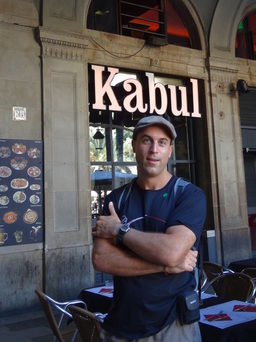 The scene of the crimes 10 years ago I was wary of being near Las Ramblas with our packs as this was the scene of the most traumatic travel experiences during my last trip through Europe ten years ago. At that time, I had my wallet stolen on the subway while my traveling companion had his camera stolen in a nearby hostel (pictured to the left) and I think another friend had theirs stolen on Las Ramblas. But we tucked our two backpacks close to our seats on the side away from the street and settled into some gazpacho and a ham and cheese baguette. At one point, the owner of the restaurant came by and said something to us in Spanish, pointing to our packs and then his eyes – reiterating the point of watching our packs. Why we didn’t secure the straps of our bags under the table, I don’t know, but we would soon pay the price. One of the roaming hoods we had seen around the restaurant, wearing a bright pink and blue collared shirt with red splotches all over his face, tapped me on the back and asked me some incomprehensible question in Spanish. I answered that I didn’t understand and then turned to Neda and asked if she had understood. She said no, and we continued eating while I patted my wallet and passport as my wariness increased. Then, one of the Englishmen sitting at the table piped up, “Hey there, I saw a hand near your rucksack there…”. 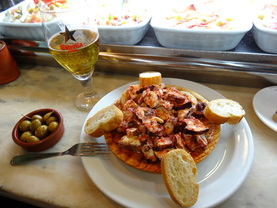 Octopus Tapas My eyes flashed over to our packs and sure enough, my black pack, with all of our electronics inside, was gone. I only had time for one “Jesus babe!”, before trouncing out of my seat and down the street. I didn’t know who had taken our packs, but it was clear that the guy in the neon pink and blue shirt was the “distraction man”. The pack was already out of sight, but I caught sight of the distraction man about 150 meters down the street, walking briskly away from us to avert suspicion. He was the last link to the bag that I had. If he got away, it was over. He was too far away to call for help – no one would understand what I was saying from that far and he could easily get away if he turned quickly and lost me. At this point, he had the advantage of distance and knowledge of the city. But I had several advantages of my own. Firstly, we had bargained for a later checkout that morning and taken the time to do yoga for the first time in weeks – leaving me warmed up, stretched out, and primed for running. Secondly, I was wearing my trusty Clark walking shoes and not my loose fitting sandals that were ill suited for running. Thirdly, I was mad as hell. I took off in a dead sprint, my knees pumping high in the air, people whizzing past me in a blur. Neda started running as well, but she hadn't had her sandals on at the time it happened and with her smaller barefoot strides she was quickly left behind. I saw the distance between us shortening to maybe 75 meters before the thief turned around and saw this Jew out of hell barreling towards him. He broke into a run and quickly cut to the right, out of my sight. But I was close enough to see where he had turned and banked after him. I found myself crossing a rounded stone arch through an empty courtyard with the thief just exiting at the other side. I was in time to see him bank left as I dashed through the courtyard, while my brain started to fully comprehend what was at stake. That bag was worth thousands of dollars to us, far more than the purely raw materials it contained. I ran faster. 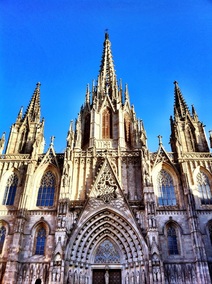 Barcelona Cathedral Once through the opposite gate I turned and was faced with two directions – straight ahead to the west or a turn right to the north. The thief wasn't in sight. Luckily, some old ladies walking down the street probably guessed what was happening and pointed me north, allowing me to lose little time in my pursuit. I sprinted up the alley to which they had pointed and came out to an isolated three way piazza with no sign of the distraction man. My heart was pumping and my legs were burning from the lactic acid that the sprint had produced. Each street of the intersection continued along for at least 50 meters without any turns – where could he have gone? How good of shape was the thief in? I had seen him slowing even through the courtyard and was sure I could catch up – unless he had some unseen doorway in which he could disappear? The piazza was part of the old city of Barcelona with two and three story stone apartments silently observing my desperation. My eyes caught site of a dumpster in the northern corner and I ran over to inspect. Sure enough, the thief was huddled behind the dumpster trying desperately not to slow his panting. Too late. I grabbed him and raised my fist, but he slipped out of my one handed grasp and ran down the street. But it was over for him. Now I knew he had no weapon and I easily followed his tired gait, intending a football tackle to pin him down and find out the whereabouts of my bag. 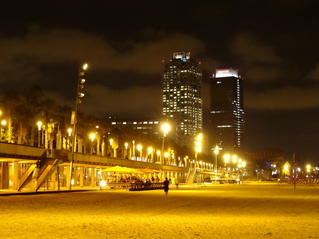 A latenight stroll on the beach A bit of luck prevented the need for any violence. As he ran away from me, he chose a street with 10 or 15 people walking in on our direction. I shouted for help telling everyone he had stolen my bag. A burly Australian (originally from El Salvador) was the first to answer my call, stepping in front of the greasy thief and prodding him backwards with his chest. Another man on a bicycle dismounted on the other side and we had him surrounded in a closing triangle. As I menacingly approached, demanding the bag, he fumbled for his pockets, pleading for a moment to call his fellow bandits. I asked the guys to call the police regardless, but while they had their phones out pretending to dial, to my dismay I later found out that neither of them had the number to call! The thief made his call and led us up a nearby street where one of his outfit was waiting, but without my bag. Then I turned around and there, walking up the street leisurely with a grey collared shirt, a man approached with my bag on his back. A surge of relief went through me as I ran over to the man and stripped the bag off of him. With the bag in hand and police nowhere to be found, the thieves slipped away as I turned to thank those who had come to my aid. The Australian’s girlfriend had walked along with us at a distance as well and they walked with me as I tried to find my way back to Neda. I was worried that she had run off – leaving her bag unattended and open to a possible double theft. While we walked, I found out the couple’s name – Walter and Simona and was in for a quite a surprise when I found out that Simona was from Stara Zagora – the town where we live (and Neda is from) in Bulgaria! It felt great to see a Bulgarian in this town full of madness and they were kind enough to walk all the way back to the café with me, where we found Neda (with her shoes this time) heading up the street in search of us. Neda described her amazement when she saw me strolling back down the street with the black straps of my bag secured snugly around my shoulders. Against the odds – we had successfully run with the thieves in Barcelona! I named the post after the famous “Running with the Bulls” in Pamplona Spain because it reminded me of a passage I had recently read in Pema Chödrön’s “When Things Fall Apart – Heart Advice for Difficult Times” about the eight worldly dharmas – or pairs of opposites that hook us (like the horns of the bulls in Pamplona) into either pursuing them or trying to avoid them. These pairs are pleasure and pain, gain and loss, fame and disgrace, and praise and blame. When we respond to them in our normal conditioned ways, we strengthen our false sense of self while creating distance from the world around us. Chödrön writes: “We might feel that somehow we should try to eradicate these feelings…A more practical approach would be to get to know them, see how they hook us, see how they color our perception of reality, see how they aren’t all that solid. Then the eight worldly dharmas become the means for growing wiser as well as kinder and more content… When we become more insightful and compassionate about how we ourselves get hooked, we spontaneously feel more tenderness for the human race. Knowing our own confusion, we’re more willing and able to get our hands dirty and try to alleviate the confusion of others. If we don’t look into hope and fear, seeing a thought arise, see the chain reaction that follows – if we don’t train in sitting with that energy without getting snared by the drama, then we’re always going to be afraid. The world we live in, the people we meet, the animals emerging from doorways – everything will become increasingly threatening.” 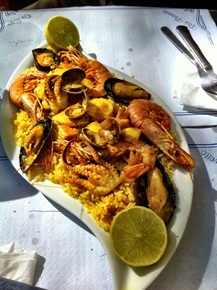 Paella! Our encounter with the thieves in Barcelona could lead us two ways. If we get hooked by the horns of fear, loss, and blame then we begin to hate the thieves, hate the city that spawned them, and close ourselves off to a world that is full of injustice, greed, and the pain that fuels them. If we just sit as the bull charges, watching the horns with curiosity and openness – then before the horns find our flesh, a tenderness towards our assailants arises that deflects the blow. Of course the thoughts of anger will arise, but if we watch them instead of following them, those thoughts become our guides towards contentment rather than our tormentors of continually re-hashed negative stories. I’ve spent 6 days total in Barcelona and have been robbed twice – the only two times in my life in fact. Despite the wonderful Gaudi architecture, charming old city, and lively people, Barcelona seems to always present challenges to the illusion of security and stability that I find myself walking around with most of the time in life. And for this gift, I bow graciously to the city – even if I won’t be returning anytime real soon :). As I mentioned, this post is out of chronological order. We are in Bulgaria now and I will be posting the rest of Spain and Portugal in their proper order: Andalusia followed by Portugal, followed by Madrid and environs. Barcelona was our last stop, but this story was fresh and had to be told! To see the pics of our time in Barcelona, click on this link:
Heading south from the Bay of Naples and the Amalfi Coast we trained down to the largest island of the Mediterranean Sea – the infamous Sicily. Sicily is a fascinating blend of cultures, which has at various times been ruled by Phoenicians, Greeks, Romans, Arabs, Normans, Spaniards, and the French. This gives it a complexity of character that we would discover was much different from mainland Italy. At the crossing from the mainland, the train disconnects and boards the underbelly of a giant ferry before unloading on the other side! In a hostel in Palermo we were talking to some younger travelers, one of whom had fallen asleep during that part of the trip. He asked us, “how did we get across to Sicily? Someone told me there was a massive bridge across.” We all had a good laugh, though frankly before the crossing I didn’t realize that trains could just roll onto ferries so easily! Our first stop off the train was in the volatile city of Catania. Nestled at the bottom of the tallest volcano in Europe and one of the most active in the world, Mt. Etna, Catania seems to derive its frenetic energy from the liquid fire that occasionally shoots into its skies. Pulling into town also brought back fond memories of one of my favorite shows growing up, The Golden Girls! Sophia is from Sicily and would often tell stories about Mount Etna and its eruptions. It’s funny that coming into the home of the Mafia you would think I would have the “Godfather” more on my mind, but instead I kept thinking of Sophia! 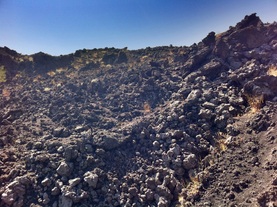 Etna Lunar Landscapes While in Catania, we marveled at how much of the town was built from the igneous rock that spurts forth from Etna every few years. In 1669, the eruptions were so severe that magma wiped out a large part of the city. Citizens then took the cooled magma and incorporated it into their city – the cobblestones on the streets and blocks of their buildings. We took a tour of the region around Etna, gaping at the 3300 meter high volcano while walking around the lunar landscape of hundreds of craters that have formed from eruptions over the years. We walked through tunnels created by the lava flow and learned about how the people of Catania cope with this looming threat over their homes by fully embracing it. The Catanians recognize that Etna is a danger to them at any moment, but they also appreciate the incredibly fertile soil that she provides and the mortar she produces from which they can build. We found it inspiring how they bring forth fertility from such destruction. A product of that fertility is the delicious wine they produce in the region from the Nerello Mascalese, Nerello Cappuccio and Nero d'Avola varietals. Another delicacy is the sweet eggplant, used to make dishes like “Penne alla Norma,” or penne with tomato sauce, eggplant, and salted ricotta cheese. 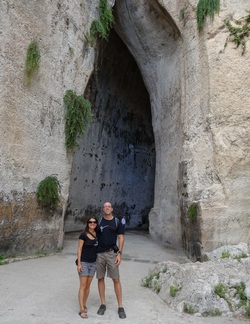 The Ear of Dionysius From Catania we headed south to Syracuse, one of the strongest cities of Ancient Greece and a competitor with Athens during that time. We spent just one night exploring the ancient ruins of the Greek city slightly outside of the town as well as in the small island of Ortygia, where the ancient city has been built over by generations of successive conquerors. Outside the city lies a beautifully preserved Greek theater, where the famous playwright Aeschylus is said to have premiered some of his tragedies. There is also an old stone quarry of the ancient town, which was used as a prison. It is famously called the “Ear of Dionysius” because the tyrant king is said to have listened to his prisoners speak from above via the chamber's well tuned acoustics. But perhaps the most interesting part of the city for us lay in the city’s Jewish history. In 1492, when Isabelle and Ferdinand completed the reconquest of Spain from the Moors, they also decided to expel all Jews from Spanish territory (which Sicily was at the time). A that point, the Jews had been a vibrant part of Syracuse’s history for nearly 1000 years so their forced removal was a gross injustice, albeit only the final one in the history of the Jews in Sicily (read more Jewish history in Sicily via the preceding link). 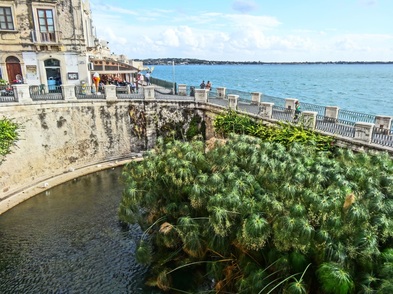 The Fountain of Arethusa overgrowing with papyrus plants Fast forward to 1994, nearly 500 years later, when the foundation of a building was being renovated to be made into a hotel in Syracuse. While digging, workers uncovered the remains of a mikvah, or ritual Jewish bath 18 meters below the ground that dated from at least 600 AD. When fleeing the city, the Jews had buried the mikvah (it took 5 truckloads of dirt to dig it out), most likely to prevent sacrilege from occurring there and in hopes of one day returning. The mikvah, believed to be the oldest in all of Europe, was used for ritual baths by both Jewish men and women. For women, they would fully immerse themselves after certain occasions like end of a menstrual cycle, after giving birth, and before marriage. The men would use it to clean themselves in preparation for the Sabbath. On an island surrounded by salt water, the Jews found an old Greek well that was fed by a freshwater spring to which to connect the mikvah so that within 24 hours all the water from a ritual bathing would be fully replaced by fresh water. It is believed that this underwater spring may also feed the famous Fountain of Arethusa located nearby on the island. It was amazing to learn how the entire mikvah chamber had been carved only with a hammer and a chisel, a remarkable achievement for the time. For us it showed the Jewish people’s dedication to this sacred place and also the connection to the land that we had also noticed in the people of Catania. Click here to read more about the mikvah. 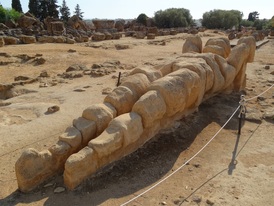 The telamons From Syracuse we stopped for a night in Lentini to meet up with Lucio, a gracious Couchsurfing host who made us a homemade Sicilian meal and told us stories of the life in Sicily. Then we headed west to Agrigento, where more Greek ruins awaited in the stunning Valley of the Temples. The valley houses the remains of 5 Greek temples built along the ridgeline of the island to honor the Gods and greet homecoming sailors. The most preserved Temple of Concordia dating from the 5th century BC shoots one back in time to when Agrigento was a prosperous city-state engaged in trade and continuous war with the regions surrounding it. The more ruined Temple of Hercules measures about the size of the Parthenon in Athens while the completely destroyed temple of Jupiter would have been even larger! That temple featured giant “telamons” between its Doric columns which held up the ceiling of the enormous temple. In the town of Agrigento itself, which sits high above the valley, we enjoyed climbing through its winding streets and sampling some fresh Sicilian treats (including a very unique pistachio cous cous) from the nuns at the Monastero Santa Spirito. 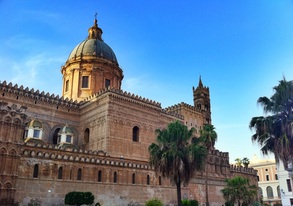 The Cathedral in Palermo We traveled north by train from Agrigento to Palermo, capital city of Sicily and fictional home of Sophia. Palermo is a fascinating city because it still retains traces of its Arabic heritage in addition to its Greek, Roman, and Norman influences. Palermo was an Arab city from 827 to 1071, after which the Normans managed to conquer it back and make it a part of the Byzantine Empire. We found the Cappella Palatina there to be a foreshadowing of our trip through Southern Spain with its heavy Arab Influence. Cappella Palatina, housed within the Norman Palaces built after the conquest (Palazzo dei Normanni) is a perhaps the most stunning mixture of Arab, Norman, and Byzantine art in the world. It combines beautiful golden Byzantine mosaics with muqarnas (Arabic style) ceilings and Norman doorways. The Norman Palaces were a snapshot of the opulence enjoyed by the ruling families of Sicily over the years. But the most infamous ruling families in Palermo are still very much present, though their power may be waning. The Mafia was born out of Sicily’s transition from feudalism to private landownership. When Italy annexed Sicily in 1860 it redistributed much of the land to private landowners, but newly formed authorities didn’t have the manpower or experience to enforce property rights and protect property from bandits. Thus were born the first mafia clans. The necessary evil of “protection” would later become a lucrative racket where local merchants had to pay for the protection of their businesses or suffer from the very people they refused to pay. We were surprised to learn from locals that 70% or more of the businesses in Palermo still pay for this protection – proof that the perception of the waning power of the mafia in the area may be fictitious. Luckily, we didn’t have any run-ins with the mafia other than the stories about protection that the locals told us. When we asked one local what happened if you don’t pay protection he said, “first you just get wax or glue in the keyhole of your door. That is your first warning. If you don’t pay after that some accident will happen to your business – a fire or a burglary perhaps.” Makes small business in America seem a lot simpler, huh? 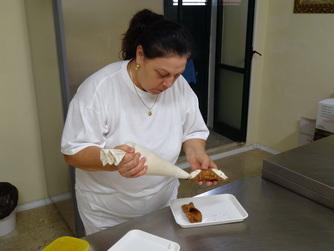 Fresh cannoli! Other than talking mafia and visiting churches we spent our time in Palermo doing what we enjoy the most – searching for the local dishes. We went on a persistent hunt through the Mercato di Ballaro looking for the “Fabrica di Cannoli,” a family owned cannoli kitchen that supplies many restaurants with their cannoli. They have a small kitchen where you can get individual orders of the delicious desert and watch the freshly made ricotta and chocolate mix squirt into the fried cannoli shell. It’s like a delicious bite of heart attack! Neda also started to fall in love with eggplant as we enjoyed eggplant parmigiana and numerous other preparations of the nightshade. We ended our stay with a tasting of the local pasta con sarde, which is spaghetti with minced sardines, fennel, pine nuts, and raisins. Certainly one of the most interesting pasta dishes we had, though not at the top of our list to try again! All in all, Sicily was a experiences in extremes. Noisy streets and even nosier people. Flavorful foods and wines and enough history to leave even the biggest buff bewildered. We loved our time there, but it was time to say goodbye to Sophia’s home and board the plane from Palermo to Seville to start our Andalusian explorations! A final quote to leave you with:
Rose: Did you know they have an egg named after you Blanche? Blanche: Oh really? How is it prepared? Sophia: Over easy. To see all the pics of Catania and Syracuse, click here: To see all the pics of Agrigento and Palermo, click here: |